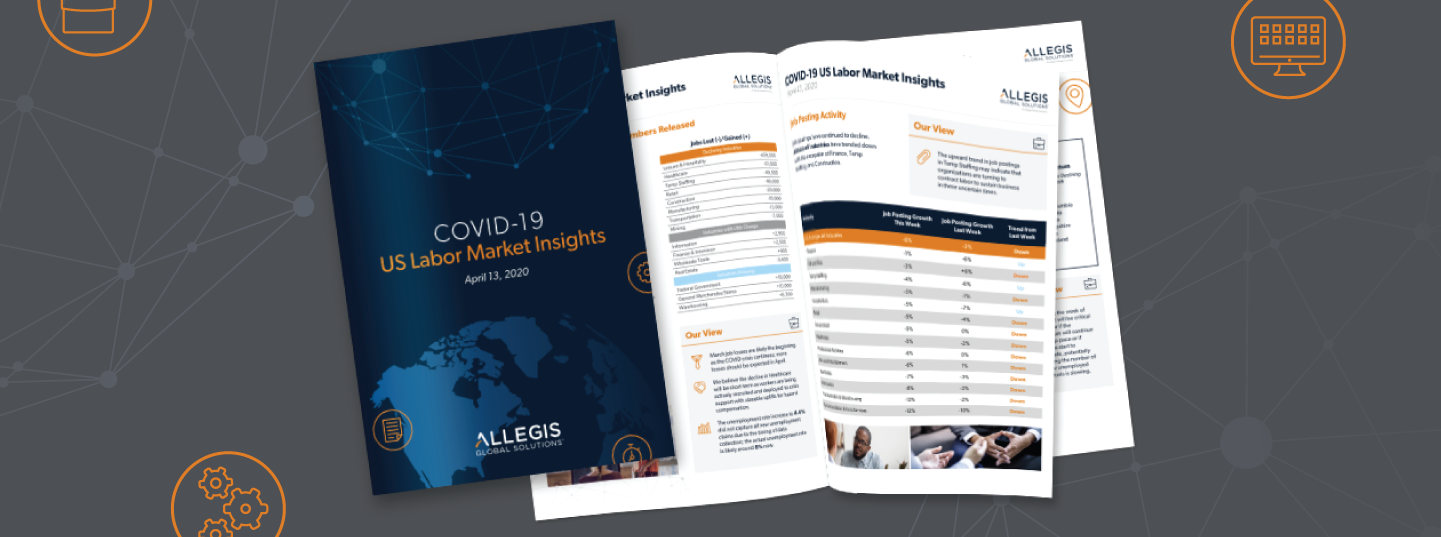A Rare Glimpse at Leading Labor Market Indicators and the Path Back to Work
 The global pandemic has unexpectedly given companies in the human capital space a unique opportunity to use data and analytics to deliver a leading-indicator glimpse into the road ahead. In a series of special labor market reports on its COVID-19 resource center, AGS taps into a wide range of data sets, including key labor market indicators, job requisitions (reqs) opened, reqs canceled, and start rates for new roles for its managed services provider (MSP) business.
The global pandemic has unexpectedly given companies in the human capital space a unique opportunity to use data and analytics to deliver a leading-indicator glimpse into the road ahead. In a series of special labor market reports on its COVID-19 resource center, AGS taps into a wide range of data sets, including key labor market indicators, job requisitions (reqs) opened, reqs canceled, and start rates for new roles for its managed services provider (MSP) business.
For business leaders, workforce decision-makers, and professionals looking to see how the job landscape is shaping up, AGS provides a valuable point-of-view on the market, as a major MSP solutions organization with clients across all major industries and over 3,000 global staffing partners.
“The special reports combine AGS findings, government statistics, and expert analysis for a detailed, concise picture of staffing and flexible workforce activity,” said AGS Analytics Executive Krista Palmisano. “The resource center currently hosts US, Canada, and UK reports. We are monitoring the markets closely, as data changes quickly in the current business environment, so it’s a good idea to check back frequently for updates.”
Based on the findings, companies face a path back to work that will require a thoughtful market perspective and well-planned resourcing decisions. Here are some key findings, drawn primarily from the US report, along with their implications. We will cover the Canada and UK reports in upcoming articles.
Worker Engagement Trends Stabilize
AGS’ first US labor market report on March 30 cited figures from the company’s daily job req activity. The results showed a remarkable 75 percent increase in canceled orders. The trend pointed to a future where cancellations could be on par with new orders within several weeks of pandemic conditions. However, as of April 13, when AGS published it updated US report, that trajectory shifted. The drop in new reqs stabilized, and the rate of canceled reqs declined. As of the week ending April 19, opened reqs had trended back to normal levels, and canceled reqs had fallen below normal levels.
What it means: The figures likely reflect companies’ shift away from the initial wait-and-see mode of pandemic response and its related reduction in flexible worker engagement. For workforce decision-makers, now is a good time to think about moving forward. Is business continuity established? Have newly remote workers settled into their routines? For positions at companies where more hiring is needed, have proper plans been put into place? If so, it is time for companies to adjust business plans and start planning for skills demands, future workforce additions, as well as reductions and pauses.
Stalled Processes Cause a Slowdown in Starts
New starts edged down from February and March across four of five categories, including scientific, engineering, IT, and professional services. Light industrial has seen a rise of 17 percent. Business uncertainty and shifting talent needs are part of the picture, but the fact that starts remain down while reqs are stabilizing suggests that onboarding processes may also be a factor. Background checks, orientation, and equipment provisioning take longer in a remote work environment, holding back starts — even for workers who companies are eager to engage.
What it means: Companies should expect their talent solutions partners to provide data and context (e.g., both new req and new start data) to deliver the most accurate snapshot of current conditions. In this case, the data shows that hiring managers and workforce decision-makers will need to account for longer hiring cycles as they make plans in a remote work environment and as activity begins to move back to onsite locations. Companies should also review their background check processes and re-assess their risk tolerance during work-from-home scenarios. A hiring manager can speed up the onboarding process by allowing workers to begin their employment on a contingent basis while waiting for non-critical elements of the background check to clear.
Certain Skills and Fields Experience Upswings
Despite high numbers of unemployment claims and a decline in reqs, several fields have experienced a rise in demand. Packers, buyers, general laborers, and mechanical engineers saw more than a 100 percent increase in starts through March and April. Other examples include web developers (up 70 percent), financial analysts (up 49 percent), and production managers (up 23 percent), among the 22 areas cited in the report.
What it means: Companies may realize a new talent need or decide to support virtual operations, execute financial business continuity strategies, or ramp-up product storage and delivery. Other organizations likely have similar needs, putting pressure on worker supply, even though general unemployment numbers would suggest otherwise. Temporary staffing and contractors are great options to fill the need, but competitors from across industries may be looking for the same workers. Companies that are hiring should plan accordingly and not assume that current conditions will yield a more readily available talent market across all skill sets in all markets.
The Government is a Competitor
The US federal government is providing a stimulus payment of $1,200 per person under prescribed wage levels. Likewise, unemployment insurance for workers laid off due to COVID-19 comes in at $600 per week for up to four months. Family and sick leave policies include full-pay for workers impacted by the virus or on quarantine (up to 80 hours), as well as pay for workers who need to care for their family members.
What it means: Many workers are on the sidelines but have government support for the time being. Since most layoffs are currently being considered temporary layoffs, they see a job waiting for them following the crisis. Some may be receiving unemployment that is higher than their original wages, so employers cannot assume that these workers will jump at any job offer. Organizations may have to prepare for higher-than-expected costs for talent as they move back into talent acquisition mode.
Wages Do Not Always Move as Expected
In March, the US economy shed roughly 700,000 jobs, and week-over-week, millions have been filing for unemployment. However, until those claims are processed, we won’t know the full labor market impact. To be sure, the losses are significant, but they may or may not add up to what was gained during the decade of expansion leading up to February 2020. Notably, more than 20 million jobs were added during that time. Many recent losses will be temporary, and much of the available talent supply will shift from heavily impacted industries and roles into areas for newly increased demand.
What it means: Wages may decline in certain areas, but any drop is unlikely to be across the board, so counting on lower wages is risky at best. In fact, March data showed hourly earnings that continued to trend upward. The best bet is to research market data, typically a resource that can be provided by a talent solutions partner, to help gauge the rates needed to secure new talent and bring workers back to the fold.
Moving Forward: Data May be Perishable, but the Underlying Priorities are Not
In a rapidly evolving economic situation, data is essential for distinguishing facts from emotion. Unfortunately, information has a very brief shelf life. Conditions will change quickly. The demand for certain skills will level off while others will increase. Even as trends evolve, talent planners can embrace several basic priorities to drive successful recovery and a path to growth. They include:
- Gain visibility into talent markets: Do not rely on hunches or past assumptions for workforce supply and rate decisions. Set costs and rates based on existing market data. Whether through internal functions or talent solutions partners, the tools for gaining visibility into workforce dynamics are available. Put those tools to work.
- Get proactive about talent sourcing and engagement: Don’t wait for a “return to normal” to start building talent pipelines, and don’t expect the workers you laid off or put on hold to come running back. Build talent pools and support them with virtual communities. Communicate with talent and keep them connected. Finally, get creative about re-deploying talent and take advantage of remote work to extend access to every part of the available talent pool. The company that does all of these things will benefit from a speedier talent recovery when it’s time to ramp-up operations.
Whether an organization emerges from this crisis stronger or weaker will depend upon the decisions they make today. Making those critical decisions requires good data, thoughtful analysis, courageous partners and a long-term view. Commit to staying on top of the workforce environment, apply the practices to stay ahead in engaging talent, and leverage the technologies and solutions partnerships to optimize speed, cost, and quality of results. Even as trends change, there is no shortcut to success. Smart tools, great partnerships, and committed stakeholders have always been essential to an organization’s survival and growth, and they remain the key to success in the future.
Get data-driven insights to help you make strategic workforce decisions using the most recent labor market data and analysis.-min.png)




